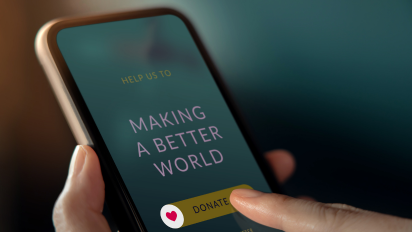The Latest
Dedicated donors. Recurring revenue. Retention percentages that you’re hesitant to openly share because they’re so great it’s almost embarrassing.
Sustainer programs are one of the cornerstones of a successful fundraising strategy, and for good reason. They create a unique bond with donors while inspiring an overall higher frequency of giving that arrives with predictable cadence. They don’t require a large financial investment to launch or revitalize given the strongest channels for acquiring and converting sustaining members are email and digital ads. And a smart and intentionally designed program can have an incredible impact on your organization. Just take a look at these stats:
- Sustaining donors give 42% more annually than one-time donors
- The retention rate for sustainers is 80% in the first year (compared to 23% retention for one-time giving)
- Once a donor decides to become a sustainer, they’ll stick with you at least three times longer than the average single-gift supporter
- The average sustainer gift is $35 a month, or a whopping—and consistent!—$425 per year (in addition to any other one-time gifts that they may contribute over the course of a given year!)
However, there’s more to creating a sustainer program than slapping a “monthly donor” checkbox on your donation forms. Developing a successful sustainer program requires its own unique strategy that works with your acquisition and annual fund programs. It entails laying the foundation, crafting unique copy and creative, and building the technical infrastructure to make it all work. And it encompasses navigating the many potential pitfalls that can hinder a sustainer program along the way.
To help you do so, here are five common sustainer program mistakes… and what to do instead.
Mistake #1: Asking everyone to be a sustaining member
We see this all the time, from well-established organizations to brand new nonprofits, the sustainer program acquisition strategy is little more than an added option to give monthly that’s tacked onto every audience segment and every channel. However, for a sustainer program to succeed, you need to look at the type of donors who are passionate about your cause AND have demonstrated that loyalty.
WHAT YOU CAN DO
Dig into your data to identify and qualify likely sustainers from your current file based on frequency of giving, preferred donation channels, and age. Although it will be different for every organization, a general guideline is to flag donors who give two or more times per year, are multichannel supporters, and have demonstrated allegiance through length of time on your file (check on their last gift and prioritizing active donors who meet your criteria over lapsed).
With your target audience in mind, consider how your copy, creative, and offer show the benefits of becoming a monthly donor. Here are a few questions to ask yourself to help you develop strategic methodologies and messaging that are specifically tailored for your sustainer prospect audience:
- What are the benefits for the donor? Why should they commit to a monthly gift rather than give when they want to?
- What are the perks to belonging to your organization’s monthly giving group?
- What is the impact that the supporter will have with their monthly gift??
- What qualitative examples can you provide to demonstrate impact and then feasibly report back on?
Mistake #2: Overlooking digital channels
For nonprofits with well-established fundraising programs, digital channels are often behind the times. We get it! When direct mail and telefundraising are racking up donations with ease, it makes sense for digital to be used as a supplementary channel. However, this is NOT the case when it comes to sustainer programs given digital channels are the #1 source for converting prospects into monthly donors.
WHAT YOU CAN DO
From online donation forms to email to social media, it all needs to be geared toward converting prospective donors into monthly donors. While one-time donations are always welcome, putting monthly donation options front and center will help your organization quickly grow its sustainer program and increase recurring revenue.
Mistake #3: Losing touch with current sustainers
This is a big one. Sustainer programs have a tendency to run on autopilot after the initial conversion. Your sustaining members’ donations are automatically transferred every month and many organizations tend to assume that there’s not a whole lot that needs to be done. In fact, sometimes it’s best to not remind them that a donor is giving every single month!
While there’s some truth to not wanting to wave the amount that donors are giving every month in their faces, you do want to keep in touch. Your sustainers are special—treat them that way!
WHAT YOU CAN DO
Here are a few ways to make sustainers feel welcome and forge a deeper relationship that could inspire additional giving:
- Make new donors feel extra welcome by giving them a special token of appreciation or writing a personalized thank you letter. And not just when they join. Thank them repeatedly throughout the year and provide them with evidence of the real-time impact that their generosity helps accomplish (remember that note above about reporting back?).
- Roll your sustaining members into select key campaigns such as a special matching gift campaign or your year-end campaign. And don’t forget to include them in your distribution lists for newsletters, impact reports, surveys, etc. All this helps keep them engaged and informed of your work (and their impact!) and potentially inspires additional gifts.
- Give them some VIP treatment. Invite them to exclusive events like a Town Hall or donor reception, provide sneak peeks of positive stories or press releases, or share event details with them before you share with your general audience.
- Invite sustainers to increase their monthly gift amount—but make sure it’s only periodically and because you have a compelling reason to do so!
However you choose to keep in touch, the goal is to continuously let your sustainers know how much they are valued and how big of an impact their gifts make to your organization.
Mistake #4: Not planning ahead for when a credit card is declined
Automatic monthly credit card charges are one of the simplest and most effective ways to receive donations. The donor enters their information and now your organization receives recurring donations on time every month—easy-peasy. But what many organizations miss are a few simple steps to prevent losing members due to simple and avoidable credit card mishaps.
The primary reason that sustaining members lapse is due to their credit card declining. There are loads of reasons that a credit card might be declined that have nothing to do with your donor’s support for your organization: the card expired, the donor got a replacement card or canceled the card you have on file. The good news is that this is something your organization can oftentimes rectify with the right protocols in place.
WHAT YOU CAN DO
When setting up your sustainer program, create business rules for what your organization will do if a card is declined. For example, how many times will you try to run the card? What’s the protocol for reaching out to the donor? What happens if you can’t run the card and can’t reach the donor?
The goal is to create a seamless system to prevent attrition based solely on credit card failures so that you retain more donors and more recurring revenue.
Mistake #5: Auditing only when something is wrong
If the word “audit” makes your heart drop for a microsecond, you’re not alone. It’s an arduous process that’s sole purpose is to tease out trouble. Who wants that? Most organizations forego audits until something is wrong—and usually it’s too late to fix the issue without a major overhaul.
WHAT YOU CAN DO
Even if an audit doesn’t dig up anything alarming, you have to know where you’ve been, where you are, and your current trajectory in order to make data-based decisions about your organization’s future. Here are a few areas to review:
- Systems: Check that all major and minor touchpoints are working seamlessly, from digital landing pages to merchant services to acknowledgment programs.
- Attrition: Keep a pulse on your sustainers so you can get ahead of any natural attrition. Find out when you typically lose new sustainers and strategize how to combat that.
- Channels: We live in an ever-changing world and your strongest channels one year ago could be wildly different now. Connect the dots between engagement, acquisition, and retention.
- Appeals and campaigns: Are there campaigns or appeals outside of the sustainers program that sustainers respond best to? Make a note and keep that in mind as you plan your next quarter.
Once your audit data is collected, take time to analyze and digest all this golden information, then get to work optimizing your program.
Looking for more information?
For more information about starting or enhancing your sustainer program, contact us at info@thelukenscompany.com.





